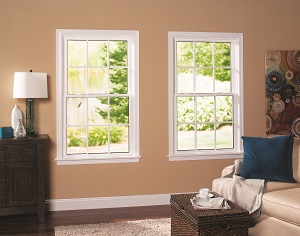When our customers look at our large selection of windows, sometimes they ask us what factors affect the cost of new windows. We carry windows for most price points so it’s sometimes difficult to tell why one window costs more than another just by looking at them.
However, windows do have construction differences that make a big difference in performance and durability and, of course, the cost of new windows.
The materials and construction methods having the biggest effect on cost include:
1. Window frame material: There are advantages and disadvantages to all types of frame materials. Generally, metal frames are used for commercial windows so they are rarely chosen for single-family homes. Fiberglass and vinyl are the most common window frames used for homes. The positive value of fiberglass is its strength. On the other hand, fiberglass negatives include its high cost and air infiltration issues. Vinyl windows range from very high-end to extremely low-end and everything in between. You need to do your research to know how to tell the difference.
2. Window frame insulation: Most modern windows have hollow cavities through which air can travel. Less expensive windows are sold with no insulation. Mid-range and higher cost windows filled with quality insulating materials. The better the insulation, the more expensive the window.
3. Single, double or triple pane glass: Residential windows generally come single, double or triple paned. Double paned windows had a huge impact on improving window energy efficiency. Triple paned windows improved on this model somewhat and are more expensive but the jury is still out on the ROI of double vs triple paned windows as far as energy efficiency and lower energy bills.
4. Window Gas: Window gas is a gas several times more dense than air. It is injected between the panes of double or triple paned windows to slow the transfer of hot or cold air. Your options usually include no gas, argon or krypton.
5. Window Coating: Low-emissivity (low-e) coatings on glass controls heat transfer through windows with insulated glazing. Windows manufactured with low-e coatings typically cost about 10% to 15% more than regular windows, but they reduce energy loss by as much as 30% to 50%. In addition to reducing energy costs, it will reduce the fading of furnishings and other fixtures in the home.
Planning for a Window Replacement Project
When setting a budget for new windows, you should think about how long you intend to stay in your home. If you plan to be in the house long-term and you have budget concerns, you always have the option of replacing a few windows at a time.
Although window replacement is a big expense, not replacing those windows can carry a big price tag as well. According to the U.S. Department of Energy, leaky and inefficient windows, skylights, and glazed doors account for more than 25 percent of the average household’s energy bills. In Iowa, that can add up to hundreds of dollars a year. In addition, if your windows have deteriorated to the point that there is structural damage, the repair costs to rotted wood and water damage can run into the thousands.
Home Town Restyling offers a wide range of replacement windows for every budget and professional installers on staff to complete the project on time and on budget. We also back up everything we do with lifetime warranty. Download our FREE Window Replacement Checklist and start planning like a pro.







